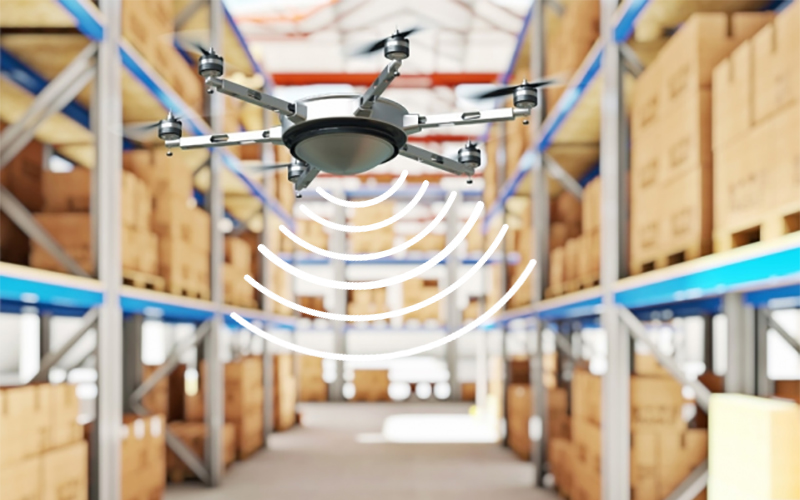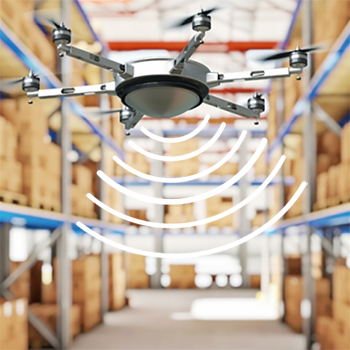Solving a $45 Billion-Dollar Per Annum Retail Problem with RFID-Reading Warehouse Drones

By coupling airborne drones with smarter RFID systems, MIT researchers have developed a system that enables small, safe, aerial drones to read RFID tags in large warehouses, possibly making missing packages a thing of the past and saving retailers billions lost through faulty inventory records.
Retailers lose $45B worth of inventory every year due to misplaced packages, stolen merchandise, and returned goods.
In 2013, Walmart lost up to $3B due to discrepancies between inventory records and actual stock, according to Forbes.
Now drone-based package-tracking tech could finally help solve this problem.
Read: Walmart Testing Warehouse Drones to Catalog and Manage Inventory
New research from MIT proposes lightweight drones that can help track and manage inventory in large-scale environments by allowing passive, long-range radio frequency identification (RFID) scanning.
RFID tags have long provided a potential solution to the problem of effective package tracking through digital cataloging. Think of it as a much more sophisticated version of barcode scanning.
However, RFID technology has been limited in implementation because the most common RFID tags are passive and short range. The battery-free “smart stickers” cannot send out a signal until they are scanned by a reader.
Thus, while RFID tags are much more useful for locating packages than a barcode ever could be, they still require individual scanning within centimeters of the RFID tag. Not only is this cumbersome and inefficient, it also doesn’t account for packages that may be located in unexpected places.
For context on how big this issue can really be, think about scanning packages in one of Amazon’s warehouses. Amazon’s Phoenix, Arizona fulfillment center, for one, is 1.2 million square feet – enough to house 28 football fields.
As a solution, researchers at MIT propose using drones as a relay between RFID tags and an RFID reader, extending the RFID reading range substantially and allowing the drone to scan for signals that might even be hidden behind other objects.
The paper details how researchers created RFly – a new system enabling drones to wirelessly detect and locate RFID-tagged packages for faster, smarter package cataloging and tracking.
The RFly technology allows a drone to act as a relay between an RFID tag and the reader that computes it (as shown in the image below). As a result, the reader can communicate with RFIDs at a far greater distance than had previously been possible – increasing the range from centimeters to over 50 meters away, even when RFIDs are detected through walls.
Based on stress tests with the RFly prototype, that represents 10x range improvement over scenarios without the drone relay. Diagrams from the MIT research paper shows how the RFly forwards information from tag to reader.
Figure 1: RFly overview and the self-interference challenge. The packets forwarded by the relay on the uplink and downlink feed back into its antenna, causing self-interference.
Figure 2: Challenge of phase entanglement. (a) In traditional antenna arrays, the phase measurements correspond to a direct link between the RF source and the antenna. (b) When the reader obtains the phase through the relay, the phase is an entanglement of two half-links: one between the relay and the drone and another between the relay and the RFID.
Credit: MIT Drone Relays for Battery-Free Networks; Y. Ma, N. Selby, F. Adib
As the video above shows, the RFly technology enables a small, lightweight drone to float through a fulfillment center and collect wireless responses from every RFID along its flight path. By combining responses, the RFly can determine each package’s location. Using the drone as a RFID relay, rather than a reader, also allows the technology to work with “a small drone, which is safe to fly indoors in warehouses and factories,” according to the MIT paper.
Even in the prototype phase, the MIT team achieved location-detection within around 19 centimeters of a package. Deployed at scale, the technology could help warehouses track missing packages down to the exact shelf they’re sitting on.
Engineers have been touting RFID tags as the ideal successor to barcodes for decades, in part due to their extremely low cost. Range issues and “blind spots,” however, have limited the use of RFID tags in supply chain/logistics to date.
The researchers also note that none of today’s commercially available RFID readers could be mounted on small drones, instead requiring larger drones “that are only safe to fly in outdoor environments or away from humans.”
By deploying small drones to track down missing packages, retailers increase efficiency in the warehouse and recoup a significant portion of their annual inventory losses. In addition, these drones may be cheaper and able to stay aloft longer than large, traditional drones.
Given its own scope and size, few will be surprised if Amazon or some other logistics giant eventually incorporates RFly, or a similar innovation, into its logistics strategy.
Amazon has a clear interest in using drones (perhaps even talking ones) for Prime Now delivery, and tech observers believe its automated Amazon Go stores will utilize RFID technology to track the movement of goods.
Source: CBInsights
Related Article Inventory Management Trends: Inventory Reduction
Article Topics
Massachusetts Institute of Technology News & Resources
MIT Restructures Itself to Shape the Future of Computing & Artificial Intelligence Solving a $45 Billion-Dollar Per Annum Retail Problem with RFID-Reading Warehouse Drones Drone Relays for Battery-Free Networks Massachusetts Institute of Technology Media Lab’s Joi Ito on Digital Innovation & Disruption NRF Reacts to NLRB Decision on Franchise Model “Outrageous!” A Preview of the MIT Production in the Innovation Economy Report MIT Report Identifies Keys to New American Innovation (and Jobs) More Massachusetts Institute of TechnologyLatest in Supply Chain
TIm Cook Says Apple Plans to Increase Investments in Vietnam Amazon Logistics’ Growth Shakes Up Shipping Industry in 2023 Spotlight Startup: Cart.com is Reimagining Logistics Walmart and Swisslog Expand Partnership with New Texas Facility Nissan Channels Tesla With Its Latest Manufacturing Process Taking Stock of Today’s Robotics Market and What the Future Holds U.S. Manufacturing Gains Momentum After Another Strong Month More Supply Chain















